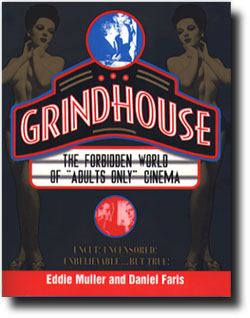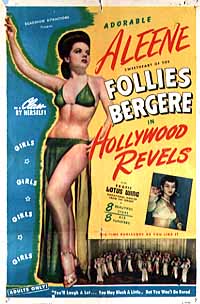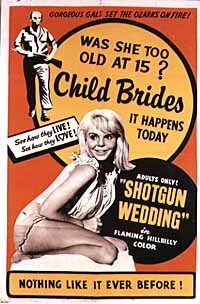




| Grindhouse Reveals the Forbidden World of "Adults Only" Cinema by Gary Johnson | |
|
Before the VCR revolution arrived, seeing an "Adults Only" movie meant venturing to a "grindhouse"--a usually seedy (sometimes decrepit) theater characterized by a sticky floor and raincoated patrons. And before the grindhouse, the ticket takers for carnival sideshows tried to lure customers with extravagant promises of sights beyond the imaginable--such as film of an exotic dancer, or a real birth, or the effects of venereal disease. | |
This is the world of "Adults Only" cinema, where posters cry out "Forbidden Desires," "Unleased Passions," and "Strange Love." And this is the world of Grindhouse by Eddie Muller and Daniel Faris, a new book packed with startling photos, lobby cards, and lurid posters--as well as an insightful text that carefully follows the history of "Adults Only" cinema, from the early '30s to the hardcore revolution of the '70s.
Grindhouse is filled with amazing artwork culled from choice "adults only" movies, but it's much more than a simple souvenir book. The authors have carefully analyzed the various time periods as they trace the development of sexploitation cinema. Starting with the introduction of the Production Code in 1933, Muller and Faris reveal how a market was created for movies that dared to show what Hollywood couldn't. Along the way they describe the sex hygiene and vice rackets movies of the '30s; the burlesque, jungle, and drug movies of the '40s; the Euro-skin, nudist camp, and nudie cutie movies of the '50s; the roughies, kinkies, and ghoulies of the '60s (not to mention the suburban sex and mondo movies); and the dawn of the hardcore era in the '70s.
This journey is enlivened by names such as Dwain Esper, the King of the Roadshows; the magnificently endowed, Tempest Storm; Kroger Babb, the all-American huckster; Doris Wishman, the queen of the nudies (and one of the few women producing grindhouse fare); Russ Meyer and his "comic-book style melodrama" with "bang the headpost sex"; Harry Novak and his sex factory; David Friedman, who made a pretty good living "exploiting the lust, greed, and ignorance of the American public"; Radley Metzger and his elegant erotica; and Marilyn "the Ivory Snow Girl" Chambers.
Grindhouse is the same size (8 ½ x 11) as many other movie books on the bookstore shelves, but its layout is anything but ordinary. Whereas many other movie books have a strictly utilitarian design, Eddie Muller of St. Francis Studio has ensured that the book is a stunner visually. Virtually every page is filled with rare stills, lobby cards, and other movie memorabilia.
Even if you've never been drawn towards "adults only" movies before, you'll find Grindhouse to be a fascinating journey.
Grindhouse: The Forbidden World of "Adults Only" Cinema by Eddie Muller and Daniel Faris, A St. Martin's Griffin publication, $19.95, softcover. |


 Muller and Faris paint a fascinating portrait of a style of filmmaking akin to hucksterism, where the poster's come-on was infinitely more important than the movie itself, where the experience of anticipating forbidden thrills far exceeded anything the movies could actually deliver. One of the wonders of the book is how clearly it traces the evolution of "adults only" cinema, showing how the movies mutated in an ever increasing lust to up the ante and provide an increasingly jaded audience with new thrills. For example, they show how the foreign invasion of the '50s helped set the court precedents which paved the way for nudist camp movies, which in turn laid the groundwork for the nudie cuties, which in one of the sickest developments in the history of "adults only" cinema, turned to violence with the roughies and kinkies--for on-screen sex was forbidden, but on-screen violence, even when combined with nudity, was okay.
Muller and Faris paint a fascinating portrait of a style of filmmaking akin to hucksterism, where the poster's come-on was infinitely more important than the movie itself, where the experience of anticipating forbidden thrills far exceeded anything the movies could actually deliver. One of the wonders of the book is how clearly it traces the evolution of "adults only" cinema, showing how the movies mutated in an ever increasing lust to up the ante and provide an increasingly jaded audience with new thrills. For example, they show how the foreign invasion of the '50s helped set the court precedents which paved the way for nudist camp movies, which in turn laid the groundwork for the nudie cuties, which in one of the sickest developments in the history of "adults only" cinema, turned to violence with the roughies and kinkies--for on-screen sex was forbidden, but on-screen violence, even when combined with nudity, was okay.